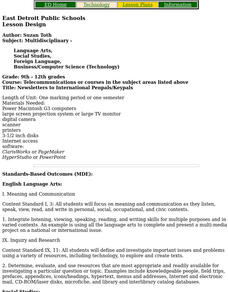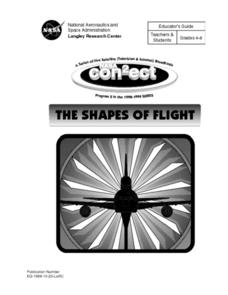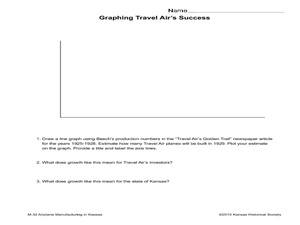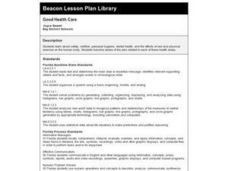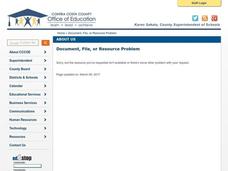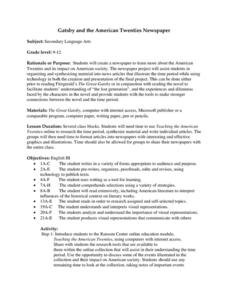Curated OER
Power Writing to Elaborate: Paragraph Writing, Main Idea
Students are walked through an outline (Power Writing) and shown how to elaborate on a main idea in their writing.
Curated OER
Newsletters to International Penpals/Keypals
Students participate in an intercultural E-mail exchange throughout a semester. They send newsletter to international penpals/keypals.
Curated OER
Regions of the United States
Fifth graders collect data about regions of the United States using the Internet, library books, and encyclopedias. They write an essay persuading people to visit their state.
Curated OER
Modeling Mitosis and Meiosis
Learners construct and manipulate models of mitosis and meiosis and compare/contrast them. They create the models using index cards and yarn, interpret diagrams and photographs, and summarize written descriptions.
Curated OER
Las Misiones de California
Fourth graders work in partners to complete a series of activities. After reading the introduction, Students select a role of either a "Padre" or "Indigena." As partners, they need time on the computer for research as well as time to...
Curated OER
The Shapes of Flight
Students explore interaction between mathematics, science, and technology as they look at process of researching, developing, testing, and evaluating airplane design. They calculate glide ratio for model paper airplane by using data...
Curated OER
Finding Science in An American Childhood by Annie Dillard
High schoolers read excerpts from Annie Dillard's memoir, "An American Childhood," with the teacher. They experience opportunities to connect English, science, nature and art together from a new and unique perspective. This approach...
Curated OER
Ancient Egypt Alphabet Book
Young scholars research Ancient Egypt using a specific letter of the alphabet as a guide. In this Ancient Egypt lesson, students independently research their assigned topic using ProQuest or other research software. Once young scholars...
Curated OER
Aquifers and Groundwater
Students understand the purpose of an aquifer. In this aquifer and groundwater lesson, students build a model aquifer find its relationship to water usage. Students record observations as they build the layers of the aquifer.
Curated OER
Why Would I Owe My Soul to the Company Store?
Sixth graders listen to "Sixteen Tons" by Tennessee Ernie Ford and discuss what it means to owe one's soul to a store. In this mathematics lesson, 6th graders determine what a miner's income was minus his expenses graphing findings in a...
Curated OER
Airplane Manufacturing in Kansas
Seventh graders determine how Kansas become a producer of airplanes. In this Kansas history lesson, 7th graders read selected Read Kansas! cards and articles. Students then discuss the primary sources they read regarding Wichita's growth...
Curated OER
Good Health Care
Students work in collaborative groups researching topics such as nutrition, the benefits of exercise on the body, dental and personal hygiene. They conduct interviews, create charts and posters, and report their results with a written...
Curated OER
Memories of School Days
Students interview, record, and retell school stories of a family member. They research, document, and describe how schools have changed over time.
Curated OER
Paul Revere's Ride
Third graders read and discuss the selection "Paul Revere's Ride" (included with the lesson). Students imagine they live in one of the villages that Paul Revere stopped. They are awakened by his knock on the door. Students write an essay...
Curated OER
All About Bats
Second graders research everything they know about bats. They find out anything about bats that was not discovered by the class and to come back and share the new information. They color their own picture of a bat and will write at least...
Curated OER
Technology: Recipes Around the World
Students research international cuisine and create Web pages based on them. Once they have organized their findings, they demonstrate their research with a multimedia presentation. The project concludes with a party using food ...
Curated OER
Problem Solving: Logical Reasoning problem solving 13.4
In this problem solving with logical reasoning worksheet, students read a word problem and write short answers to show the steps for understanding, planning, solving, and checking. Students write four short answers.
Curated OER
Gatsby and the American Twenties Newspaper
Students research 1920's US History. In this historical literature instructional activity, students use the novel The Great Gatsby as a tool to examine the era. They work in individually to create newspaper articles based on...
Curated OER
Ellis Island/Angel Island
Fourth graders research Ellis Island and Angel Island. In this library media lesson plan, 4th graders use resources from the library to locate facts about Ellis Island and Angel Island. Students construct a Venn diagram to compare and...
Curated OER
Death On Board La Belle: Finding Clues from Old Bones
Learners practice analyzing skeletal remains for clues by using the Internet. In this scientific investigation lesson plan, students research the La Belle shipwreck using the Internet and written materials, later completing a...
Curated OER
Student Mad Libs
Young scholars investigate the different parts of speech by participating in a fill in the blank activity. In this Mad Libs lesson, students define the different parts of speech and discuss how they are used appropriately in sentences....
Curated OER
Adding and Subtracting Polynomials Using Algebra Tiles
Students add and subtract polynomials. In this algebra lesson, students use algebra tiles to perform operation of polynomials. They model their problems and understand how to combine like terms using tiles.
Curated OER
4 Corners Pre-reading Strategy for A Raisin in the Sun by Lorraine Hansberry
High schoolers consider different statements based on the themes from Lorraine Hansberry's A Raisin in the Sun, and decide what they think of the statement. They share their ideas as a class and discuss all sides to a idea.
Curated OER
Classifying Candy I
Students explore the observable properties of matter. They develop two binary classification systems using concrete objects. based on two different properties of the concrete objects.

